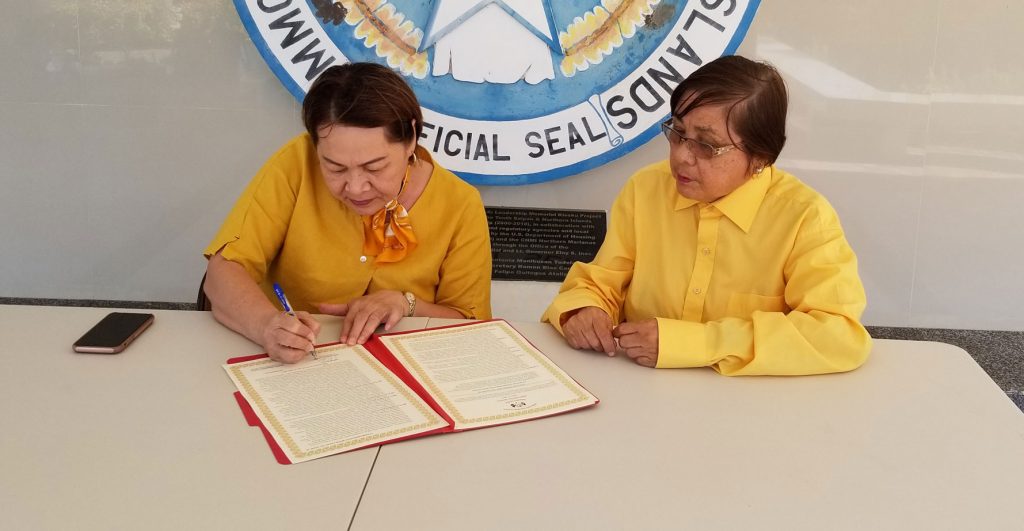Council calls for a study on status of Chamorros in the CNMI

Saipan and Northern Islands Municipal Council chair Ana Demapan-Castro, left, and vice chair Antonia Manibusan-Tudela sign the resolution that calls for a comprehensive study on the status of the Chamorros in the last 500 years. (CONTRIBUTED PHOTO)
The Saipan and Northern Islands Municipal Council passed a resolution at its April 1 session that calls for a three-year comprehensive study on the status of the indigenous people of the Northern Marianas 500 years since Ferdinand Magellan stumbled upon the Marianas on March 6, 1521, up to now.
Based on the resolution, council chair Ana Demapan-Castro and vice chair Antonia Manibusan-Tudela wants to obtain comprehensive data on the status of the Chamorros in the last 500 years since colonization to decolonization of the Marianas region, specifically the CNMI, and to determine whether the promise of “a higher standard of living” for Chamorros as outlined in the 1976 Covenant with the United States has been achieved.
The resolution—Council Commemorative Resolution 16SMC-01—urges both the CNMI and federal governments to fund this study.
The resolution is titled “To commemorate and recognize the [500th anniversary] since the accidental arrival of Ferdinand Magellan on March 6, 1521, and the arrival of the Spanish navy ship Juan Sebastian de Elcano on Feb. 26, 2021, in Guam, and the impact since on the Chamorro, the indigenous people of the Mariana Islands.”
The study will be spearheaded by the Northern Marianas College, the CNMI Indigenous Affairs Office, and Matua Council for Chamorro Advancement, a nonprofit indigenous organization.
This resolution stems from the recent brief visit by Spain’s navy ship Elcano in Guam that retraced Magellan’s “Armada de Molucca” circumnavigation of the world in search of the Spices Islands or Molucca Islands in Indonesia 500 years ago today. The Elcano arrived in Guam on Feb. 26, 2021, and departed on March 2, 2021 depicting almost the same duration of stay when Magellan abruptly left the Mariana Islands on March 9, 1521.
The study shall provide the status of the Chamorros since the arrival of Magellan in the Marianas 500 years ago and provide information on Spain’s eventual occupation of the Mariana Islands for over 200 years to evangelize the Chamorros on Catholic teachings and the use of the Northern Mariana Islands as a stopover route to the Philippines, Molucca Islands and Mexico since 1660s up until 1898. It shall also provide the status of the Chamorros during the brief occupation of Germany after the Northern Marianas was sold by Spain in 1898 as part of the $4.2 million acquisition and occupation of the Northern Marianas for economic development; and when the Northern Marianas became a protectorate of Japan from early 1900s to 1941 under the League of Nations, the predecessor of the United Nations, and until the end of World War II in 1945.
Further, the study shall provide the status of the Chamorros under the United Nations Trust Territory of the Pacific Islands with the United States as the administering authority over all the Micronesian Islands, including the Northern Marianas from 1945 up until the signing of the Covenant in 1976.
Furthermore, the study shall provide the status of the Chamorros after the date of the Covenant on March 24, 1976 to March 24, 2021—45 years to date, to see whether the CNMI is attaining or regressing on the objective and spirit of the agreement in achieving a higher standard of living for the indigenous people.
The Northern Marianas have been pushed for economic development from all the major countries in the Asia region – Japan, Korea, and China since the opening of the flood gate after the first constitutional government in January 1978.
Among the aspects that the study will look at are the status of the Chamorro’s native language at home and in schools, including educational advancement in STEM (Science, Technology, Engineering, Math) careers, trade, and technical skills; their health condition; access to subsistence living; traditional gathering rights; and incarceration rates, status of available land for homestead and agriculture; and access to shorelines for sustainable fishing and harvesting.
More importantly, the study will provide policymakers a roadmap in drafting future public policies that affect the social, economic, cultural, and traditional issues to mitigate the decline in language, health, education, subsistence living and traditional gathering rights that are critical to ensure continuity of the protection, preservation, and survival of the Chamorros for generations to come. (PR)



























